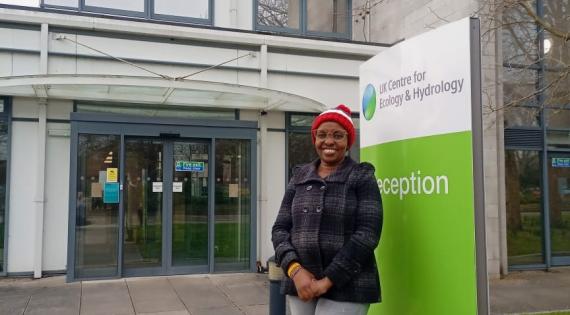Jemimah Gacheru is a weather forecaster based in Nairobi, Kenya. From 3 February – 14 March 2025 she visited UKCEH Wallingford, working in particular on the science around extreme heat events in Kenya, but also becoming involved in a wide variety of new initiatives to improve climate modelling and forecasting exchange between the UK and Kenya.
Why forecasting matters
Heat stress, a condition that develops when the body fails to maintain its internal temperature due to extended exposure to high heat and other factors, has become a growing problem in Kenya and around the world. The awareness of this issue is also increasing, with a number of stories in the local media.
Jemimah is a Principal Meteorologist at the Kenya Meteorological Department (KMD). Her passion is delivering accurate forecasts that are practical, accessible and really improve people’s lives. “We try as much as possible to engage with our people because we realised operating in a silo does you no good, you need to interact with the people that you're serving, whether it be the people at the grassroots or even big organisations”, she said. Her connection with UKCEH developed from shared involvement on the GCRF Africa SWIFT project (2017 – 2022); a project which focused on improving forecasting capability across African partners.
Jemimah’s 2025 visit to UKCEH had the same objective of as its heart. She visited to work with UKCEH scientist Guillaume Chagnaud to test the effectiveness of forecasting heat stress using the existing KMD models with a goal to help people in Kenya better adapt to this new weather extreme.
Collaboration at UKCEH
Alongside her testing of the existing KMD models, Jemimah also found ways to bring immediate practical improvements to forecasting in Kenya. One example is her work developing a prototype heat index tool. This tool can take existing temperature and humidity data from KMD’s models and calculate an apparent, or “feels like”, temperature – helping people around Kenya understand what the temperature will actually feel like on a particular day, so they can be better prepared. Jemimah is now in the process of testing and demonstrating this tool within KMD and then it could be rolled out.

For Jemimah, it is vitally important to take the step to make science practical, useful and accessible. As she says: “Once a tool is produced that is easy for a forecaster to use, then essentially UKCEH has reached the last mile. But the researcher can only know to develop a tool that a forecaster can use if they actually talk! Because we know the people, we know what they need. The researcher knows all the science. So we come together and we come up with something that is very nice and very usable.”
Looking ahead
Further collaboration seems likely to continue. After the visit, UKCEH scientist Christopher Taylor gave a training session to 25 KMD staff in the use of their Nowcasting tool. Additionally, thanks to Jemimah making connections, other KMD staff will be involved in the JULES Academy training programme with will run in September 2025, with the goal of introducing climate scientists and professionals across Africa to the Joint UK Land Environment Simulator (JULES) community land surface model.
Reflecting on her visit, Jemimah said, “The science has been amazing. You never quite understand the kind of effort that goes into creating those tools and just being here interacting with the scientists that research those tools has really opened up my mind!”